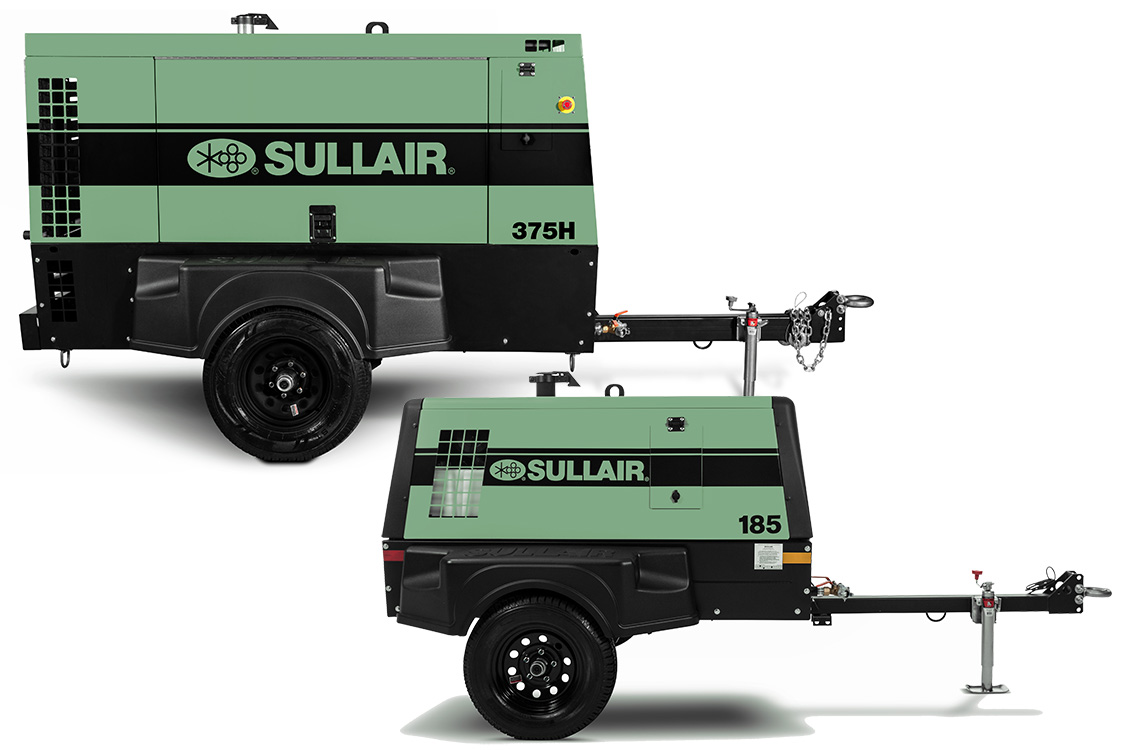Air Compressors Reimagined: Sullair introduces new Tier 4 family of portable air compressors
written by Chad Elmore for Diesel Progress magazine May 2016 - click here for full article
With the recent introduction of the “reimagined” 375 T4F family of portable rotary screw air compressors, Sullair is filling out its catalog of machines that meet U.S. Environmental Protection Agency (EPA) Tier 4 final emissions regulations.
The company is accepting preorders for the 375, which is expected to start production this quarter. The Sullair 185 T4F portable rotary screw air compressor family introduced last year is in full production at the company’s factory in Michigan City, Ind. It produces 185 cfm at 100 psi.
Compared to its Tier 4 interim predecessor, Sullair said models in the 375 T4F air compressor line provide customers a more compact design, better serviceability and a higher range of pressure. Airflow ratings from 375 to 425 cfm and 100 to 200 psi offer more job site flexibility, the company said. The 375 family includes several models designed to meet different applications. Those range from the 375, which has 375 cfm and 100 psi, to the 425H with 425 cfm and 100 or 150 psi. The 400HH, which has 400 cfm and 100 or 200 psi, is the latest addition to the family. In Sullair’s nomenclature, the H and HH signify pressure rating: H is 150 psi and HH is 200 psi. Those units allow the user to run at a higher power with the flip of a switch.
“When we say reimagined, we mean we made even more changes to better meet customer requirements,” said Nav Sharma, senior product manager, Sullair. “Customers need a reliable machine that makes air day in and day out. We were already there with our airends, and we have always used reputable engines, so those were never an issue. The airend has always been a forte for Sullair. It’s bulletproof. In speaking with customers, we found we could improve the packaging to help make their work simpler and easier.”
Knowing the air compressors are popular in the rental market, Sullair engineers made them easier to service to reduce equipment downtime as well as labor hours for technicians. “We put a huge focus on servicing and maintaining the machine; even more than before,” Sharma said. “If maintenance is difficult, it sometimes doesn’t get serviced, and that can reduce the life of the machine.”
The engine and airend on the new 185 and 375 units were placed in the middle of the enclosure with service locations located on either side. “Anything that will be touched by a technician during regular maintenance was pulled out and put on the periphery of the machine,” Sharma said. “It is all very accessible. When you open the clamshell canopy of the 185, the engine oil filter, compressor oil filters, air filters, dipstick, battery and fuse boxes are all right there.”
The 375 canopy has gullwing doors on the sides and swing doors on the end for access when cleaning the cooling system and other tasks.
The engine used in the Sullair 185 T4F is a Kubota B1803 diesel, while the 375 T4F compressors get a Caterpillar C4.4 diesel engine. In both cases, engineers opted to go with engine-mounted aftertreatment. Sullair developed the control panel in-house and works with a local supplier for its manufacture. Both models share the same panel, and it was carried over from the Tier 4 interim air compressors.
The Kubota engine uses a diesel oxidation catalyst (DOC) and diesel particulate filter (DPF). “The DPF is invisible to the end user,” Sharma said.
The Caterpillar engine in the 375 air compressor uses a DOC and selective catalytic reduction (SCR) to meet EPA Tier 4 final emissions standards.
“For the 375, we understood from our customers that a lot of rental fleet users are not yet used to DEF (diesel exhaust fluid) and could fill the wrong tank,” Sharma said. “While the tanks have a green cap (for diesel) and blue cap (for DEF), to further avoid filling errors or confusion, we put the DEF tank on the other side of the diesel tank.”
The company is developing a webinar to help train distributors and explain the differences, including maintenance issues, between Tier 4 final and older machines.
The overall size of the new 375 is smaller than the Tier 4 interim version, Sharma said. “The Sullair 375 is one of the most compact in its class, and that’s to help keep the machine towable. If the 375 increased in size, contractor customers might feel uncomfortable towing them behind a pickup truck. It was a challenge to package everything in there and still keep it serviceable, but our technical group has done an excellent job doing so. We had some help from engine manufacturers, as well.”






